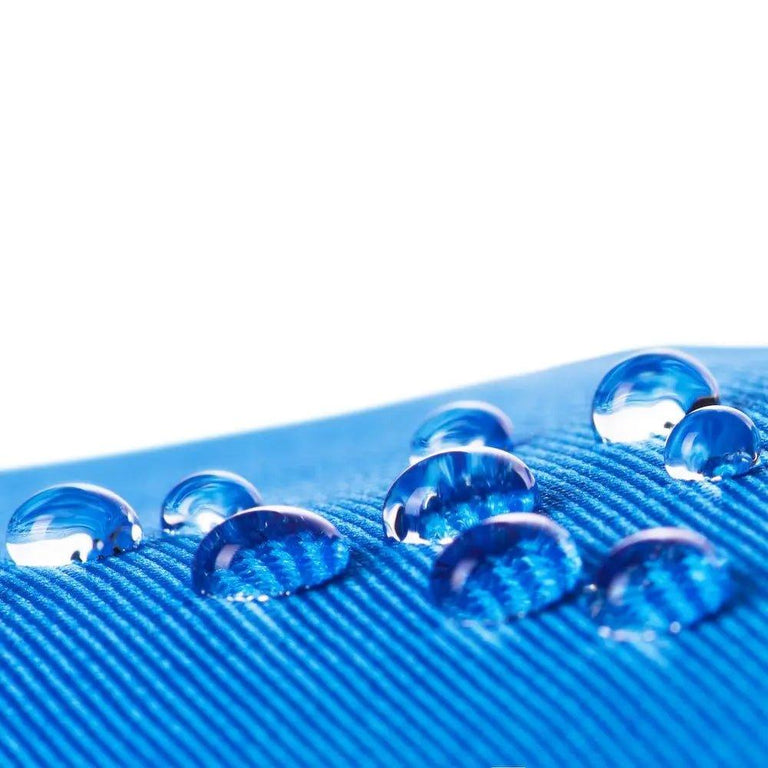Choosing between waterproof and water-resistant fabric depends on your needs, whether for outdoor gear, beanbags, or clothing. This guide explains what makes fabric waterproof, how it differs from water-resistant and water-repellent fabrics, and what to consider when selecting materials for your projects.
What is Waterproof Fabric?
Waterproof fabrics are designed to prevent water penetration, tested by Hydrostatic Head (HH) to measure resistance under pressure. Sealed seams are essential for true waterproofness, as even the best material will leak if stitching allows water in. Waterproof fabrics are commonly used in raincoats, tents, outdoor furniture covers, and premium beanbags requiring moisture protection.
Waterproofing can be achieved by:
-
Adding waterproof coatings (PU, silicone).
-
Bonding waterproof membranes (ePTFE as in Gore-Tex).
-
Using tightly woven synthetic fibres like polyester, which naturally resist moisture.
Waterproof vs Water-Repellent vs Water-Resistant
-
Waterproof: Completely blocks water penetration under pressure.
-
Water-Repellent: Water beads off the surface but may penetrate under pressure.
-
Water-Resistant: Resists some water but offers minimal protection in heavy rain.
Understanding these differences helps you choose the right material based on the intended use.
Types of Waterproof Fabrics
Here are some commonly used waterproof or water-resistant materials:
-
Laminated Cotton: Natural feel with a waterproof backing, ideal for hats and jackets.
-
Polyester & Nylon: Naturally water-resistant due to tight weaves, can be coated to become waterproof.
-
Vinyl & Plastic: Fully waterproof and flexible, used in covers and bags.
-
TPU (Thermoplastic Polyurethane): Soft, breathable, eco-friendlier than PUL.
-
Polyester Fleece: Water-resistant when thick, can be treated for added protection.
-
Polyurethane Laminate (PUL): Waterproof, breathable, used in baby products and covers.
-
Wool: Naturally water-resistant, can be treated for additional protection.
-
Oilcloth: Cotton or linen coated with oil or vinyl for full waterproofing.
Top Waterproof Fabric Brands
-
Gore-Tex: ePTFE membrane with polyurethane coating, breathable and waterproof.
-
Pertex Shield: PU laminate for lightweight waterproofing.
-
Polartec Neoshell: Air-permeable, waterproof with stretch for comfort.
Fabric Printing and Care
-
Use RGB colour mode and 200dpi resolution for printing clarity.
-
Sublimation printing is ideal for synthetic waterproof fabrics, ensuring durable prints.
-
Gentle hand washing is recommended to prevent fading or crocking.
-
Avoid harsh chemicals to maintain waterproof coatings.
Applications of Waterproof Fabrics
Waterproof fabrics are used across industries:
-
Fashion: Jackets, hats, shoes requiring moisture protection.
-
Outdoor Gear: Tents, sleeping bags, and waterproof beanbags for poolsides.
-
Medical: Mattress covers and protective equipment.
-
Home Furnishings: Shower curtains, outdoor cushions, and protective covers.
When selecting fabric for custom projects, consider the intended use, breathability needs, and durability requirements.
Environmental Considerations
Many waterproof fabrics are made from synthetic fibres, which may contribute to microplastic pollution and require chemical treatments. However, the industry is shifting towards recycled materials and eco-friendly waterproof coatingsto reduce environmental impact. Choosing high-quality waterproof fabrics and maintaining them well extends product life and reduces waste.
Certification and Standards
Look for certifications like:
-
ISO 811: Measures waterproofness.
-
Oeko-Tex Standard 100: Indicates the fabric is free from harmful substances.
These ensure your fabric meets safety and performance standards.
Summary
Waterproof fabrics play a critical role in keeping you and your products dry while offering a range of textures, weights, and breathability. Whether you need fully waterproof material for outdoor beanbags or water-resistant fabric for clothing, understanding the differences and testing standards will help you make informed choices.
If you plan on custom printing, prepare high-quality artwork in RGB at 200dpi, and select the appropriate printing method to maintain the waterproof qualities while achieving vibrant results.
Choose wisely, maintain well, and enjoy the benefits of waterproof fabrics in your lifestyle and business projects.




